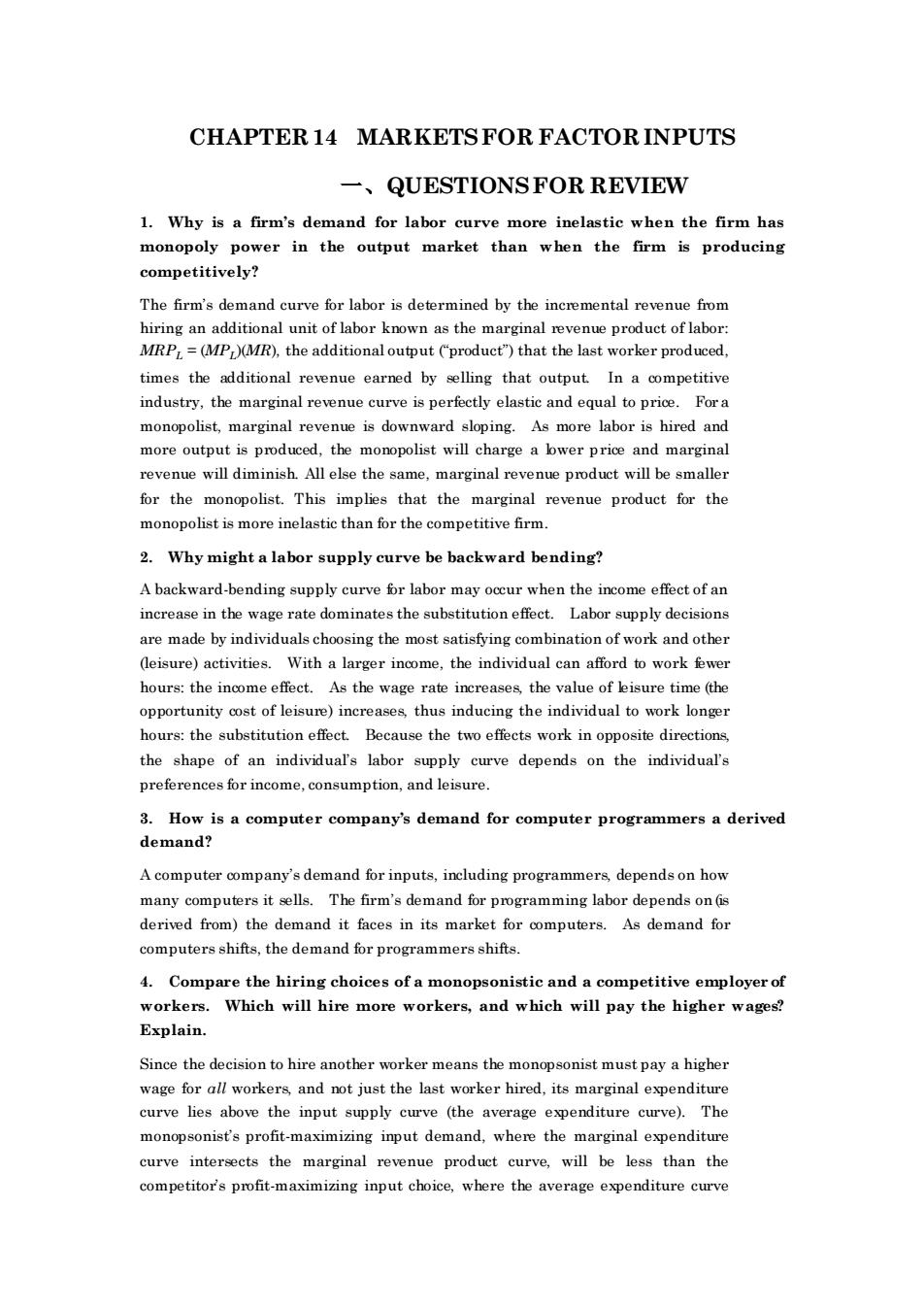正在加载图片...

CHAPTER 14 MARKETSFOR FACTOR INPUTS 一、QUESTIONS FOR REVIEW 1.Why is a firm's demand for labor curve more inelastic when the firm has monopoly power in the output market than when the firm is producing competitively? The firm's demand curve for labor is determined by the labor known as the product of ab )the adaoa upu Curduc that the latworker pdu ag出 times the additional revenue earned by selling that output.In a competitive industry.the marginal revenue curve is perfectly elastic and equal to price.Fora monopolist,marginal revenue is downward aloping.Asmore labor is hired and more output i monopolist will charge a bwer price and revenue will diminish.All else the same,marginal revenue product will be smalle for the monopolist.This implies that the marginal revenue product for the monopolist is more inelastic than for the competitive firm. 2.Why might a labor supply curve be backward bending? A backward-bending supply curve for labor may occur when the income effect of an remade by individuals ch leisure)activities. With a larger income,the individual can afford to work fewer hours:the income effect.As the wage rate increases the value of kisure time (the opportunity cost of leisure)increases thus inducing the individual to work longer hours:the substitution effect.Because the two effects work in opposite directions the shape of an individual's labor supply curve depends on the individual's preferences for income,consumption,and leisure. 3.How is a computer company's demand for computer programmers a derived demand? A computer company's demand for inputs,including programmers depends on how many computers it sells.The firm's demand for programming labor depends on (is derived from)the demand it faces in its market for computers.As demand for computers shifts,the demand for programmersshifts 4.Compare the hiring choices of a monopsonistic and a competitive employer workers.Which will hire more workers,and which will pay the higher wages? Explain. Since the decision to hire another worker means the monopsonist must pay a higher wage for all workers and not just the last worker hired,its marginal expenditure curve lies above the input supply curve (the average expenditure curve).The monopsonist's profit-maximizing input demand,where the marginal expenditure curve intersects the marginal revenue product curve,will be less than the competitor's profit-maximizing input choice,where the average expenditure curveCHAPTER 14 MARKETS FOR FACTOR INPUTS 一、QUESTIONS FOR REVIEW 1. Why is a firm’s demand for labor curve more inelastic when the firm has monopoly power in the output market than when the firm is producing competitively? The firm’s demand curve for labor is determined by the incremental revenue from hiring an additional unit of labor known as the marginal revenue product of labor: MRPL = (MPL)(MR), the additional output (“product”) that the last worker produced, times the additional revenue earned by selling that output. In a competitive industry, the marginal revenue curve is perfectly elastic and equal to price. For a monopolist, marginal revenue is downward sloping. As more labor is hired and more output is produced, the monopolist will charge a lower price and marginal revenue will diminish. All else the same, marginal revenue product will be smaller for the monopolist. This implies that the marginal revenue product for the monopolist is more inelastic than for the competitive firm. 2. Why might a labor supply curve be backward bending? A backward-bending supply curve for labor may occur when the income effect of an increase in the wage rate dominates the substitution effect. Labor supply decisions are made by individuals choosing the most satisfying combination of work and other (leisure) activities. With a larger income, the individual can afford to work fewer hours: the income effect. As the wage rate increases, the value of leisure time (the opportunity cost of leisure) increases, thus inducing the individual to work longer hours: the substitution effect. Because the two effects work in opposite directions, the shape of an individual’s labor supply curve depends on the individual’s preferences for income, consumption, and leisure. 3. How is a computer company’s demand for computer programmers a derived demand? A computer company’s demand for inputs, including programmers, depends on how many computers it sells. The firm’s demand for programming labor depends on (is derived from) the demand it faces in its market for computers. As demand for computers shifts, the demand for programmers shifts. 4. Compare the hiring choices of a monopsonistic and a competitive employer of workers. Which will hire more workers, and which will pay the higher wages? Explain. Since the decision to hire another worker means the monopsonist must pay a higher wage for all workers, and not just the last worker hired, its marginal expenditure curve lies above the input supply curve (the average expenditure curve). The monopsonist’s profit-maximizing input demand, where the marginal expenditure curve intersects the marginal revenue product curve, will be less than the competitor’s profit-maximizing input choice, where the average expenditure curve